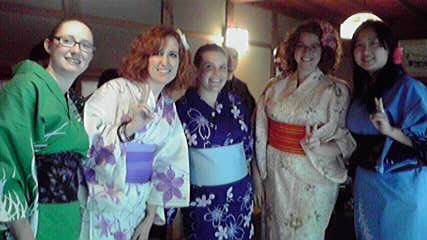
Japanese traditional cloth is 着物【KIMONO】. There are many kinds Wedding, ceremonies, parties, dates, tea ceremony, museum, fireworks and festivals in summer, sightseeing experiences…
What kimono should you wear? We will show very fundamental knowledges about kimono!
CONTENTS:
1.Basic 8 kinds of KIMONO depend on the situations.
2.Basic kinds of OBI
3.How to wear KIMONO?
4.What items do you need to wear KIMONO?
5.How to make KIMONO in Japan?
If you wanted to wear kimono in Japanese life,
these knowledges will help you so much.
There are basically eight types depend on whether married or unmarried, the length of the sleeves, kind of fabrics, the place of the patterns,
number of 紋【MON】crests, so on.





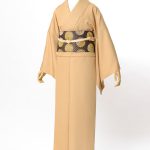

1.振袖【FURI-SODE】The most formal kimono for unmarried women with long sleeves.
ESSAY:What does "weaving sleeves" mean in ancient Japan?
2.留袖【TOME-SODE】(黒留袖【KURO(Black)-TOMESODE】:The most formal Kimono for married women with short sleeves colored in black.
色留袖【IRO-TOMESODE】)Colored short sleeves kimono for married and unmarried women. ESSAY:What's 紋【MON】Family crests? The ranks of kimono differ depends on the number of MON.
3.訪問着【HOMON-GI】:Literally means "Visiting kimono". Patterns are put on only shoulders, chest and hem.
4.付下げ【TSUKE-SAGE】Similler to visiting kimono,but all patterns are not connected when it turned out.
5.色無地【IRO-MUJI】No patterns, only one color kimono.
6.小紋【KOMON】Small or middle sized patterns are spread all over kimono.
7.浴衣【YUKATA】The most casual summer kimono made of cotton or linen, wear without 襦袢【JYUBAN】underwear.
8.THE OTHER KIMONOS ・紬【TSUMUGI】・縮【CHIZIMI】・ウール【WOOL】・絽【RO】・紗【SYA】・羅【RA】
ーーーーーーーーーーーーーーーーーーーーーーーーーーーーーーーーーーーーーーーーーーーーーー
1.振袖【FURI-SODE】 Literally means “Waving Sleeves” .The most formal kimono for unmarried women.

The most formal kimono having long sleeves only for unmarried women.
It has gorgeous classic patterns like flowers, running water, ancient ox cart, so on are painted and covered by colorful decorations of embroideries or gold and silver foils.
They are wore by brides in weddings, the most formal parties and ceremonies, or very formal tea ceremony like 初釜【HATSU-GAMA】the first tea ceremony in the year.
Coming Soon <<GOLDFISH TOURS>>日本【NIHON/JAPAN】<新潟県【NIIGATA‐PREFECTURE】<<十日町【TOUKA-MACHI CITY】 / Kimono fabric product city and hold large KIMONO-Festival in May or October .
In ancient time, ”waving sleeves” mean notifying feeling of love to someone she loves.
So, women married, they wear 留袖【TOME-SODE】literally means stop sleeves, not long sleeves any more.



<The length of sleeve has
three types in 振袖【FURI-SODE】>:
●大振袖【OO-FURISODE(Large long sleeves)】
●中振袖【CHU-FURISODE(Middle longsleeves)】
●小振袖【KO-FURISODE(Small long sleeves)】
・大振袖【OO-FURISODE】
Large Furisode : The longest sleeves at most ankles. It looks so gorgeous, colorful and luxury.
Bride of wedding, Formal ceremony like coming-age-ceremony, Formal parties, 初釜【HATSU-GAMA】Tea ceremony for the first time in a year.
・中振袖【CYUU-FURISODE】Middle Furisode : , Middle length sleeves, reach calves.
Formal Parties, Coming-age-ceremony.
・小振り袖【KO-FURISODE】Small Furisode: Length of sleeves are about thighs.
They are worn at graduation ceremony of colleges. It is popular to wear them with 袴【HAKAMA】skirt in Japanese university’s graduation ceremony.
This style has started in MEIJI era which Western style started to mix with traditional kimono style and sometimes they wear Boots.
2. 留袖【TOME-SODE】Elegant 黒留袖 【KURO-TOME-SODE】, literally means “Black Short Sleeves”.

It is the most formal kimono for married woman. Atmosphere is so noble and elegant. It is worn by bride’s mother at wedding party or formal ceremonies like graduate or entrance. It is also called 江戸妻【EDO-ZUMA】.
Pattern is only written on the bottom of kimono.
With black-high quality silk base kimono, classic patterns decorated by gold or silver is painted.
Usually, 帯【OBI】belt matched is also woven by silver or gold strings ones.
Kuro Tome-Sode has totally five 紋【MON】crests on both breasts, both shoulders and back.
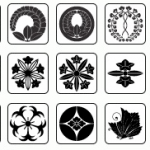
ESSAY ABOUT 紋【MON(Crest)】/ 家紋【KA‐MON(Family-Mon Crest)】
家紋【KA-MON (family Mon Crest)】 or 紋【MON】 is a symbol mark transmitted to each family for generations. Each Japanese family has family MON crest passed down from generation to generation traditionally. Types of them are over 5 thousand.
There are falling wisteria, Bamboo and sparrows, Paulownia, Hollyhock or mallow, Wings of Hawk, so on.
3.色留袖【IRO-TOME-SODE】Colored short sleeves kimono.



色留袖【IRO TOME SODE( Colored Short Sleeves) can be】 can be worn by married and unmarried woman as formal to semi-formal ware. For example, bride’s sister and relatives in wedding party.
On the base of high quality silk colored kimono, pattern is only painted around the hem.
Woven 帯【OBI】is tied in 二重太鼓【NIJYUU-DAIKO(Double-Drum Style)】.
Depend on the owner who tailor it, 0, 1 , 3 or 5 紋【MON】are put. 5紋’s IROTOMESODE ‘s 格【KAKU(rank)】is same as KUROTOMESODE.
For example, five MON crest IROTOMESODE is for mother, grand mother, sister in wedding , or very formal ceremony like confer decorations ceremony of royal palace. Three crests is for formal party or friends or relatives of bride in wedding. Single crest is to semi-formal party or 茶会【CHAKAI】tea party.
4.訪問着【HOUMON-GI】“Houmon-gi” literally means “Kimono for visiting”.
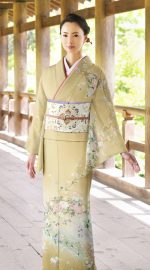
訪問着【HOUMON-GI】literally means visiting Kimono. Regardless married and unmarried, guest of wedding, parties and ceremonies as semi-formal.
On Various color’s base, patterns from classic to modern are painted.
Patterns are arranged not only around bottom part, but also on shoulders and sleeves, too .
Because those patterns are lined like one picture when spread out, so HOUMON-GI’s 格【KAKU(Rank)】 is higher than TSUKE-SAGE.
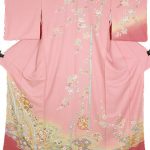
5.付下【TSUKE-SAGE(Put and Down)】
付け下げ【TSUKESAGE】looks similar to Houmongi, but a way of tailor is little different. Tsuke-sage literally means put and down; it’s from a way of tailor.
As same as Houmongi, TSUKESAGE’s patterns are placed on hem, shoulder and chest and sleeves. However, when it was spread out, all patterns are not connected while Houmongi ‘s patterns look like one picture( It needs more work and cloth to do so). So, Tsukesage’s 格【KAKU(Rank)】 as kimono is lower then Houmongi.
However, if you attach one crest to Tsukesage, it will be higher than Houmongi without a crest.
It’s complicated and difficult~💦
World of Kimono is profound and that IS
interesting. Ho Ho Ho.
6.色無地【IRO-MUJI】literally means colored plain kimono.
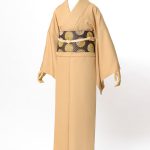
色無地【IRO-MUJI】literally means “colored plain” kimono.
One color and no patterns kimono made of high quality silk.
If you put one crest, you can go to wedding ceremonies and formal tea ceremonies enough.
Even it looks simple, it’s a high class and formal, expensive kimono.
ESAAY: <江戸小紋【EDO-KOMON】, almost same rank as IROMUJI is very small pattern are on it and it looks almost plain seeing from far. It developed between SAMURAI of feudal society, who are not allowed to wear elaborate kimonos has created.>
7.小紋【KOMON】Small or middle sized patterns are spread all over the MOMON kimono.
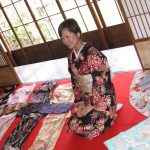
小紋【KOMON】is kimono small or middle size patterns are spread all over on it.
It is good for temporary going out like lunch, date, casual tea ceremony e.t.c. like formal one piece.
Usually, in formal occasions 半襟【HANERI(Half collar)】and 足袋【TABI(sox)】are white, but if it was not formal scene, you can wear colored and patterns’ ones.
Recently cheap polyester, washable Komon is very popular among young people. In this case, you can match 半幅帯【HANHABA-OBI】half wide casual OBI like 浴衣【YUKATA】and you need not some items and it’s more easy to wear.
8.浴衣【YUKATA】Yukata is the most casual type of kimono.
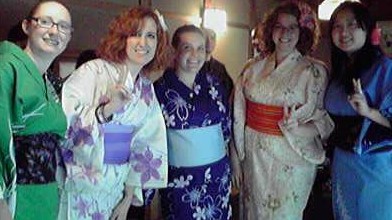
You need not to wear JYUBAN under shirts but wear only YUKATA.
Usually, when you wear kimono NAGA-JYUBAN; Jyuban long under shits the same shape as a kimono and washable 半襟【HAN-ERI】is sewn around the neck , under Kimono.
A Naga-jyuban is just like a shirt or blouse wearing under a suit. YUKATA is very popular to go to festivals, fire works so on in summer.
Other kind of KIMONO different of fabric and depend on season.
All kind of Kimonos except YUKATA and casual polyester KOMON is made of expensive silk called 正絹【SHOUKEN】.They are tied and painted in traditional 友禅【YUUZEN】tecnique.
●紬【TUMUGI】
紬【TUMUGI】made from low rank silk which has nodes and not uniformed.
So, their surface is not smooth but have unique structure with rough feelings, and it attract people who like 粋【IKI(sophisticated, cool)】 KIMONO .
Strings are tied at first and then woven.
・結城紬【YUUKI-TSUMUGI】・大島紬【OOSHIMA-TSUMUGI】・塩沢紬【SHIOZAWA-TSUMUGI】are famous depend on product places and techniques.
●Kimonos only for mid-summer
They are only able to wear in mid-summer and it hears so extravagant. However, wearing those mid-summer KIMONOS with a sunshade parasol, looks you so sophisticated, elegant and matured. Why don’t you try it ?
合わせ【AWASE】and 単衣【HITOE】
Usually, kimonos are tailored with back cloth and it is called 合わせ【AWASE】. YUKATA and other kimonos for summer is tailored without back cloth and only one-layer, then they are called 単衣【HITOE】.
●縮【CHIJIMI】is very cool Kimono visually and actually only for mid-summer. They are made from plant named 苧麻【CHOMA】, kind of hemp or ramie.
●小千谷縮【OZIYA-CHIJIMI】is the most famous and their clothes are breached on the snow in deep snowy country to be more bright and supple fabric.
●絽【RO】●紗【SHA】●羅【RA】 They are all kimonos only for summer. Ways of woven are meshed and looks extremely cool.
帯【OBI】:5 Kinds of 帯【OBI(Sash belt) 】and other items you need to wear 着物【KIMONO】.
1.袋帯【FUKURO-OBI】 2.丸帯【MARU-OBI】The most gorgeous, formal OBI. 3.名古屋帯【NAGOYA-OBI】 4.半幅帯【HANHABA-OBI】 5.兵児帯【HEKO-OBI】
1.袋帯【FUKURO-OBI】Formal and semi-formal.
Back and front clothes are sewn together like a bag and there is no pattern on the back side.
It’s basically suitable for 振袖【FURI-SODE】黒留袖【KURO TOME-SODE】色留袖【IRO TOME-SODE】訪問着【HOUMONGI】, so on.
The wide is about 30 cm and length is about 4 meters 30 cm.
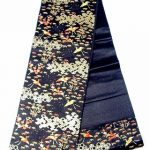
2. 丸帯【MARU-OBI(Whole Obi)】The most formal 帯【OBI】for brides, princess or traditional performances like 能【NOH】or 歌舞伎【KABUKI】.
The heaviest, longest and the most gorgeous OBI hold and sewed holding double-wide cloth. Patterns are on front and back, both. It is difficult to tie by oneself.
It’s rale and used for only bride costume of wedding, 芸者【GEISYA】/芸妓【GEIGI】, 能【NOU】,歌舞伎【KABUKI】, 日本舞踊【NIHON-BUYOU(Japanese traditional dance)】.

3.名古屋帯【NAGOYA-OBI】
Part wrapping about body is hold half and sow, and easy to wear.
It’s suitable for 付下【TSUKESAGE】小紋【KOMON】紬【TSUMUGI】.
Length is about 3m 60 cm, wide is about 30.4 cm.
一重太鼓【ICHIJYUU-DAIKO(One layered drum)】shape is orthodox to tie.
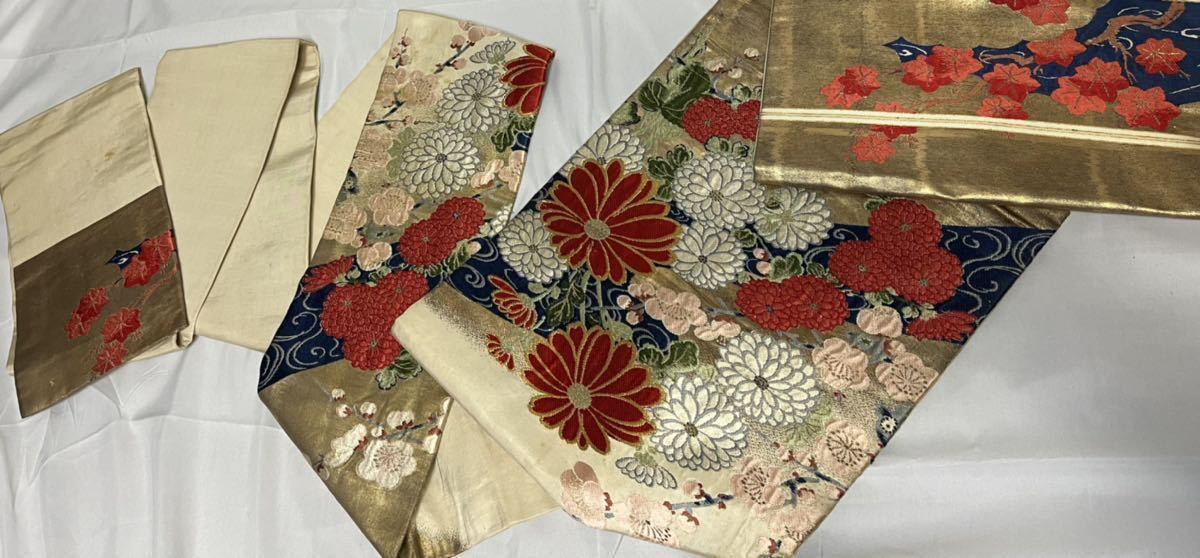
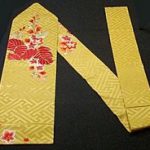
4.半幅帯【HANHABA-OBI】
半幅帯【HANHABA-OBI】literally means half-wide OBI. Wide is about 17 cm, length is about 3.6 ~ 4 m. It is suitable for casual 小紋【KOMON】and 浴衣【YUKATA】.
You need not 帯揚【OBI-AGE(cloth to hold OBI)】 nor 帯締め【OBI-JIME(string to hold OBI)】and easy to tie and very casual OBI.
Some of them are reversible and you can enjoy color contrast depend on shapes of tie.literally means half-wide OBI. Wide is about 17 cm, length is about 3.6 ~ 4 m. It is suitable for casual 小紋【KOMON】and 浴衣【YUKATA】.
You need not 帯揚【OBI-AGE(cloth to hold OBI)】 nor 帯締め【OBI-JIME(string to hold OBI)】and easy to tie and very casual OBI.
Some of them are reversible and you can enjoy color contrast depend on shapes of tie.

5.兵児帯(へこおび)
兵児帯(へこおび)is soft, tie-die crape OBI. It is used for 浴衣【YUKATA】of men or children.
Recently, women use for YUKATA, too.
Wide is from 50 to 74 cm. It’s very easy to tie, without any practice, just make a butterfly knot.
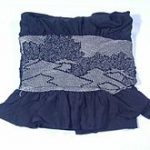
Kimono’s 格【KAKU(rank)】:”Painted” is higher than ”Woven” while about to Obi’s rank, ”Woven” is higher than ”Painted”.
There is a word “Painted KIMONO and woven OBI”.Instead of it, Woven Kimono and Painted OBI” is good.
3. What you need when you wear KIMONO?
1着物【KIMONO】/ 2.帯【OBI】 /3.草履【ZORI】 or 下駄【GETA】/4. 足袋【 TABI】/5.襦袢【JYUBAN】6.半衿【HAN-ERI】/7.帯揚【OBI-AGE】/8帯締【OBI-JIME】/9. 羽織【HAORI】 or COAT(in cold season)
<Under wear>10.肌襦袢【HADA-JYUBAN】
<Tools to wear KIMONO>11.腰紐【KOSHI-HIMO】(2〜3)/12.伊達締【DATE-JIME】/13帯枕【OBI-MAKURA】/14帯板【OBI-ITA】/衿芯【ERI-SHIN】

▶︎ESSAY:3parts important to make coordination of kimono pleasant much more;半襟【HAN-ERI】half-collar , 帯締【OBI-JIME】strings to hold OBI, and 帯揚げ【OBI-AGE】rectangle cloth shown on the top area of OBI.

Leave a Reply